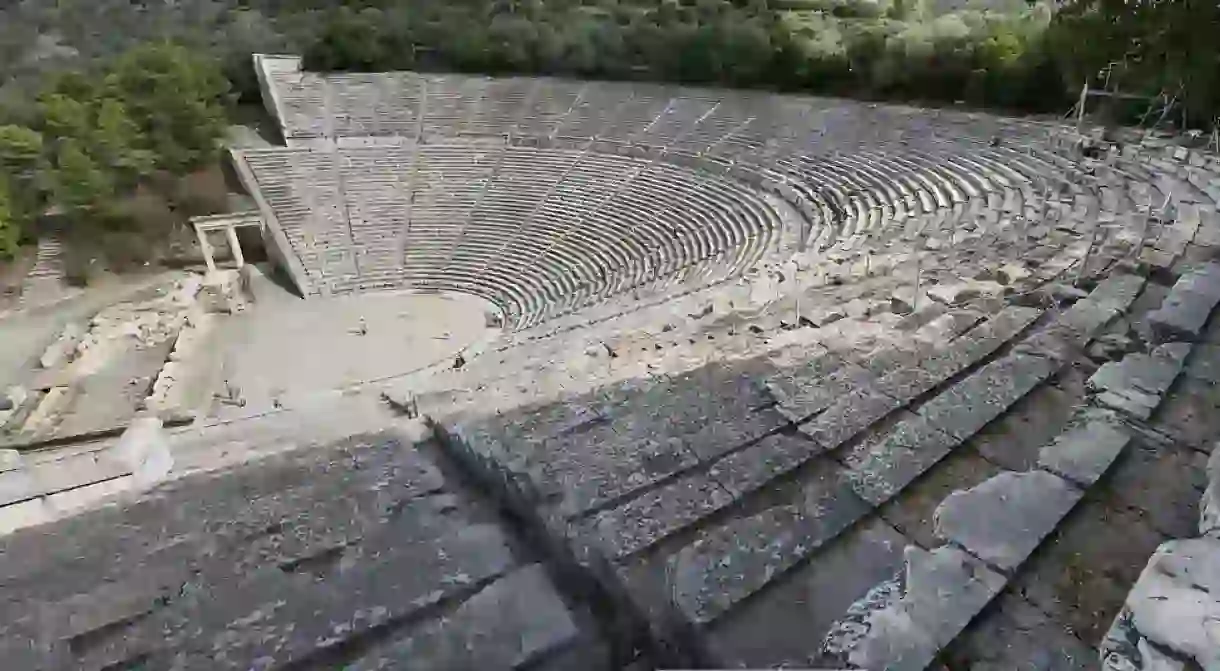A Very Brief History Of Epidaurus Ancient Theater, Greece

Probably the most beautiful and best preserved of its kind, the theater of Epidaurus was built in the 4th century BC by Polykleitos the Younger. Due to its excellent acoustics and condition, the ancient theater is still used today, most notably under the framework of the annual Epidaurus Festival. Here is a brief introduction to the Ancient Theater of Epidaurus.
Located on the fertile plain of Argolida, in the eastern part of Peloponnese, the Sanctuary of Asclepius at Epidaurus was an important sacred healing center during ancient times. Asclepius, also spelled Asklepios, was believed to possess healing powers that he learned from his father, Apollo. Therefore, the area attracted people from all over Greece who came to be treated by the resident priests. And with time, and as the center developed, prosperity increased, which the priests used to build an impressive complex of facilities, including temples, baths, athletic venues, and the theater.

Built in 340 BC, the theater seats about 13,000 spectators. It was built in two phases – one during the 4th century BC and the second in the mid-2nd century – and divided into two parts: one for citizens and one for priests and authorities.
The acoustics in the theater are incredible; indeed, spectators in the back rows have been known to hear comedians on stage without any amplification. And in 2007, the mystery of the excellent acoustic quality of the theater was resolved. At first, it was believed that the structure’s location was the cause – it was built on the slope of Mount Kynortio at an incline of 26 degrees. But researchers from the Georgia Institute of Technology discovered that while this is partially true, the real reason is the seats themselves. The steps act as ‘acoustic traps,’ filtering any background noise while creating a phenomenon called ‘virtual pitch,’ which allows for a higher clarity of sound, making it easier for spectators in the back row to hear what’s happening on stage.

In use for several centuries, the theater was destroyed in 395 AD as the Goths invaded the Peloponnese. Later in 426 AD, Theodosius II closed the Sanctuary, banning all pagan activities throughout Greece, while the site was permanently out of order following a series of earthquakes.
The impressive monument remained covered until 1881 when excavations took place under the guidance of the Greek Archaeological Society. And while their work found that the stage-building no longer existed, they uncovered the auditorium, which was still in good condition. The news quickly got around, attracting the attention of the general public.
The discovery of the ancient theater was closely linked to the persistent demands to use ancient facilities for cultural and commercial purposes. And so in 1907, repairs were made to the western aisle and retaining wall. Restoration resumed soon after WWII and focused on making the monument safe and suitable for performances. Since 1938, hundreds of theatrical plays have been performed, and in 1954, the famous Epidaurus Festival, now called the Athens-Epidaurus Festival, was launched. Held every summer, the event features both acclaimed dramas from the past and contemporary plays that are performed not only in Athens but also the ancient theater. Throughout the years, the festival has gained popularity in Greece and abroad.













